1
Tatamagouche Creamery - painting20th Century 1993
Tatamagouche, Nova Scotia Canada
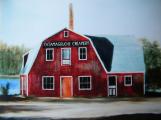 Credits:
Credits:Creamery Square Heritage Society
2
A painting of the Creamery after it had been enlarged and before recent alterations took place. This building is fondly remembered by many of the older generation in Tatamagouche and this undoubtedly influencd the later decision to develop the square and keep the buildings in it.Scotsburn Co-op Services Ltd bought the Creamery in 1968. They later built and ran the Feed Mill (Grain Elevator), Warehouse (later the Co-Op building) Hardware and Feed Store
Scotsburn closed the Creamery in 1992. By then economic changes, Government policies and milk quotas had reduced the number of dairy farmers - of the 1200 who originally supplied cream very few were left and they had changed to milk production, or beef cattle. Many of the farmers looked for work elsewhere- some going to the salt works at Malagash, others moved out of the province. But Tatamagouche survived through determination and the strong feeling of community that has existed from the early challenges, to the present day.
3
The Ice House when it was in use at the Creamery20th Century. Circa1950
Tatamagouche, Nova Scotia Canada
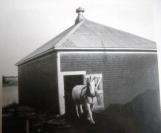 Credits:
Credits:North Shore Archives
4
The Ice House - built at a time when refrigeration was unavailable. The ice blocks from local lakes were stored here to provide the necessary cold water for the Creamery.The moving of the Ice House in 2009, was an exciting time - with only inches to spare between the Creamery and the Farmers' Market as the building was negotiated to its new position, settling perfectly on a new foundation. So the Ice House will become the foyer to the Performing Arts Centre, (recently renamed The Centre for the Arts) but more about both, later.
5
Stilts Building20th Century- 1930 /1960
Tatamagouche, Nova Scotia Canada
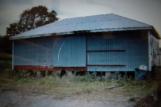 Credits:
Credits:Creamery Square Heritage Society
6
The Stilts building was once known as the King's Store because it stood at the top of Station Road on the King property. When this building was lost in a fire the store was moved to Creamery Square where it housed feeds, fertilizer and Brewers Yeast. The Intercolonial Railway ran very close to the building so it was a simple matter to unload the supplies which were then collected by farmers.Raised up on stilts the assorted rodents were kept at bay.
7
Moving the Stilts building21st Century 2008
Tatamagouche, Nova Scotia Canada
 Credits:
Credits:Creamery Square Project Office
8
The Stilts building was in the way of the proposed site for the Performing Arts Centre so it was moved in 2009 to the upper parking lot, and raised off the ground. The Bavarian Society were taking it over and were supposed to move it to another site but in 2012 this still had not been done. It currently stores chairs needed for the Oktoberfest.9
Feed Mill (Grain Elevator)20th Century. Circa 1950/60
Tatamagouche, Nova Scotia Canada
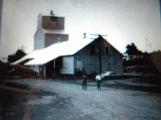 Credits:
Credits:North Shore Archives
10
A North view of the Feed Mill and Warehouse with the Hardware in position. The Warehouse, built in 1950, was originally used as a feed store.and later as a rental portion of the operation.The Feed Mill, or Grain Elevator, built in 1957 , was constructed in the 'post and beam' method, entirely of wood. It measures 70 feet (23 meters) high and has a full concrete basement
Again being next to the railway, grains from the Western Provinces could be relatively easily unloaded from railcars - the doors opening on the side of the cars meant grain could be scooped out straight into the Feed Mill.
The different grains were elevated up the inside of the mill and stored in huge bins from which the different mixes required by farmers could be formulated and bagged using sacks made on the premises.
When the Feed Mill closed Scotsburn offered it to the Creamery Square - but funds were not available, and maintenance would have been too high. Only when it was threatened with demolition did two local people step in to buy it.
Today it is an artisan and boutique market. Eventually, if funds are found the elevator might become a museum, meanwhile it is an attractive part of the Square. The Hardware is a gift store, but also sells ice cream and desserts.
11
The Feed Mill (Grain Elevator)20th Century. Circa 1957
Tatamagouche, Nova Scotia Canada
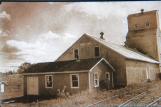 Credits:
Credits:North Shore Archives
12
South view - The warehouse and feed store. A hardware store was added to the warehouse and the name later changed from Masterfeed to the Co-Op. These carried a wide variety of stock, including wire netting, barbed wire, tools, nails, birdseed, dog food, soya beans, salt licks, motor oil and gardening products. Every year there were very popular sales of chickens, geese, and ducks, brought in by local farmers.The track of the Intercolonial 'short line' railway can be seen running close by in this picture.
Despite the closing of the Creamery in 1992 , the site remained a busy place until the closure of the Feed Mill followed by the Co-Op in 1995. By then the railway having ceased to operate, grain was trucked in on '18 wheelers' but it became uneconomic to continue, so all such activities on the site ceased..
13
Shed building20th Century. Circa 1992
Tatamagouche, Nova Scotia Canada
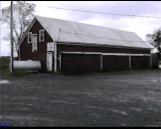 Credits:
Credits:North Shore Archives
14
The Shed Building - this two storey structure, with heavy sliding doors, once served as a garage for the trucks that collected the cream from farmers, between 1925 and the 1980's..Until the changes in farming practise took place, and cream was no longer the main product of the area, the trucks had several routes to follow two or three times a week, collecting the cream cans from the many small farms and returning the empties. The cans were unloaded here and after emptying were sterilized and then reloaded in 'farm order' for easy drop off along the routes. Every farmer had a number which was painted in red on his cans.
Much work has been carried out in this building. The second floor needed to have strong supports to house the surplus artifacts for the Heritage Centre. It held a large amount of rubbish accumulated over the years, which had to be sorted through before disposal. Shelves were built to take the artifacts, but some work is still needed on these to identify and label them correctly. Time to do this is restricted by extreme heat in summer and cold in winter. Experts have been called in to identify large collections of old tools and assorted bottles.....there are the broken remains of old looms and spinning wheels, furniture and assorted objects, the origins and donators of which are unknown.
There is talk of taking part of the storage area and creating an art studio - for teaching purposes. This will mean another re-organising of the stored artifacts, but such a room could be useful for any kind of class visit. - provided everyone can manage the stairs!